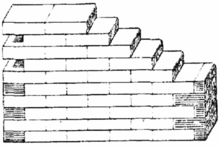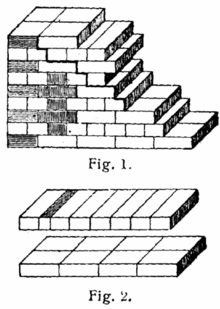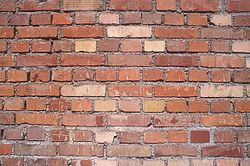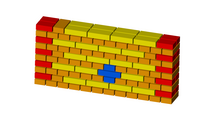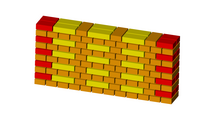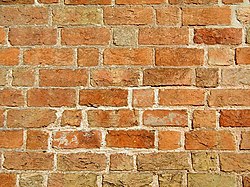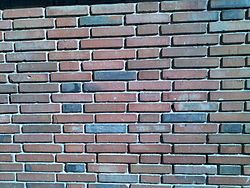Masonry association
With brickwork the type of arrangement of artificial and natural bricks as is bricks , clinkers and ornamental within the masonry designated. The type and thickness of the mortar in the joints affect the appearance of the masonry. There are different types of dressings, often named for the regions in which they have traditionally been used.
For natural stone masonry , which, like dry stone and quarry stone masonry, is composed of stones of irregular size, many of the rules listed here regarding bond, runners and trusses cannot be applied.
Basic terms
In principle, bricks are mixed when building a wall , this is the technical term for laying in a bond . In order to distribute loads and forces evenly in the body of the wall and to avoid breaking points, bricks are not laid exactly on top of one another, but offset from one another. Comprises the wall thickness of more than one brick width, the stones, layer by layer (depending coulter ) respectively and mixed along once transversely to a fanning out to prevent the wall. A brick walled lengthways is calledRunner walled acrossBinder . The narrow side visible on the tie is also referred to as the head , it is then also called the headstone , the tie in general can also be located inside the association. The cornerstone is a special structural case .
Analogously, the corresponding masonry layers are referred to as runner or binder layer . If all the stones are placed upright in a binder course, this rolling course is called , with the head pointing upwards, the grenade course . Roll layers are used, for example, as an exterior window sill or as decorative elements in the masonry. Special forms of the rolling layer are the tooth cut (stones offset from one another in the depth) and the set cut (stones offset at an angle to the wall axis). A rich palette of 47 different forms of masonry association were realized in the Samanid mausoleum in Bukhara in the 10th century AD.
In the fortress construction, layers of electricity were also used to increase stability in particularly strong walls . Current layers were built as filling layers inside the wall with stones laid at an angle of 45 to 60 degrees in order to distribute horizontal forces (through impacts or ramming). The outer sides were then covered with a facing wall.
The horizontal joint is called a bed joint , the vertical butt joint .
The stones for height adjustment are called Kimmstein . Accordingly, the bottom layer, if it only contains stones for height adjustment, is called the chimney layer .
history
The small-format and soft-fired bricks of the past centuries were mostly laid next to each other in several rows in order to obtain a wall with sufficient width and load-bearing capacity. To avoid cracks and bulges , load-bearing masonry was walled up in a bond.
The wall thicknesses were measured in whole stones, calculated in brick length. 1-stone masonry in the new Reichsformat still used today is 24 centimeters thick. For multi-storey town houses from the Wilhelminian era , 1.5 to 3-stone masonry (37 to 74 centimeters) was common in the basement and ground floor. On every first to second floor , the wall narrowed by half a stone. To produce light, non-load-bearing partition walls , bricks were also walled up on edge . In some countries (e.g. Greece ) this economical construction is still in use.
Today masonry associations only play a subordinate role. Load-bearing walls can be made faster and cheaper with large, industrially manufactured blocks in a simple stretcher bond or in reinforced concrete . High labor costs make traditional masonry in Europe uneconomical.
Today, traditional stone formats are almost exclusively used as exposed or decorative masonry ( facing masonry ). The facing wall is single-layer and the masonry bond is often only hinted at. Instead of binder stones, shortened running stones are used as heads. The supporting effect is taken over by the brickwork. The front wall protects against driving rain and is mainly decorative.
Classification
The masonry must be laid in a bond for safe load absorption, distribution and transfer even in the event of settlement phenomena and vibrations. DIN 1053-1 (masonry, part 1: calculation and execution) specifies the minimum overlap dimensions according to which the necessary overlap (overlap) of "stacked" stones is determined. The wall connections themselves are not standardized, but enable faster work progress by avoiding partial stones. When walling pillars , arches , vaults , etc., special rules must sometimes be observed.
When executing the wall association (MV), a distinction is made between the MV for wall ends (end associations) and the MV for the center of the wall .
| Classification of masonry associations (MV) | |||
|---|---|---|---|
| MV for the middle of the wall | MV for wall ends (end connections) | ||
Wall connections for the center of the wall
Structural associations (structural associations) that adhere to the minimum overbinding dimension, do without partial stones or should appear simple and regular, in contrast to decorative associations, do not allow much freedom of design.
Special associations are rarely used today. They were used, for example, to increase the tightness against driving rain. Savings associations and the use of fragments are not permitted today.
One-stone masonry has dominated since the introduction of large - format heat - insulating stones. Instead of the highly resilient multi-stone masonry made of small-format solid stones, sand-lime brick - flat elements or reinforced concrete are used today.
| MV for the middle of the wall | |||
|---|---|---|---|
| Construction associations (supporting associations) | Decorative bandages, e.g. B. for exposed masonry | Special associations against driving rain | Savings associations with fragments,
not allowed today |
| Construction associations (supporting associations) | |||
|---|---|---|---|
| for one-stone masonry
(The wall layers only have one row of stones.) |
for multi-stone masonry (bonded masonry)
(The layers of the wall sometimes have two or more rows of stones.) |
||
| Truss association
(Header bond) |
Runner association, central and dragging
(Stretcher bond) |
Block association
(English bond) |
Cross brace
(English Cross bond) |
Wall connections for the end of the wall (end connections)
General rules for all end associations:
- The stones at the ends of the wall result from the bond in the middle of the wall and the length of the wall.
- The end stones (end blocks) require each other in pairs.
- For all end connections there are four options for the end stone (end block) of the other end, depending on the wall length.
The end stones of one end of the wall force the end stones of the other end over the continuous layer. Seen in this way, the bricklayer could calmly wall at the other end. But in reality, the wall ends (corners) are pulled up first, in order to lead up the middle as cord masonry. The wall ends, which are mutually dependent on each other, are bricked independently of each other. The bricklayer must anticipate the dependency of the wall ends in planning and lay out the layers accordingly if he wants to avoid pass stones (partial stones) in the middle of the wall.
End connections for one-stone masonry
- The first layer starts with a whole.
- The beginner in the second layer results from the desired bond in the middle of the wall.
- The layers end with the partial stones that fill the end (required quarter stones are not placed at the end of the wall, but a stone is pulled forward to prevent them from falling out at the end.). The partial stone dimension results from dividing the wall length by the stone dimension.
End connections for multi-stone masonry (bonded masonry)
- Since the layers consist of several rows of stones, the terminations of end blocks are used. They are to be designed in such a way that the subsequent butt joints become the kerf of the layer and enable the desired bond in the center of the wall.
| End connections for bonded masonry according to the wall length, l | |||
|---|---|---|---|
For small-format stones, (x = whole number) can be written:
l = x ∙ 2 am + (0 am bzw. 1 am) l = x ∙ 2am + (¼ am bzw. 1¼ am) |
|||
|
Normal association
(l = integer multiple of the stone length or half the stone length)
|
overturned bandage
(l = integer multiple of the stone length or half the stone length plus ¼ stone length)
|
||
- The end bonds are also divided according to the partial stones. If quarter stones are not allowed, one speaks of a regular bond . If quarter stones are allowed, one speaks of a simplified bond .
- A normal association or an overturned association can therefore be implemented as a regular association or as a simplified association.
Bandage types
The associations are named differently depending on how the trusses and stretcher follow each other and the joints. The names of the types of association are sometimes used more generally or refer to a very special pattern.
Support bandages
In the case of supporting structures in the narrower sense, the focus is on load distribution and load-bearing capacity.
Runner association
If bricks are arranged in the longitudinal direction of the line of the wall with the respective offset of the next set by half a length, this is referred to as a runner bond . At the end of every second row, a 1/2 stone is walled up in order to achieve offset butt joints. With a pure stretcher bond, the wall thickness corresponds to the head width of the stones ( half- stone wall ). With traditional brick formats, the shell wall is around 12 cm thick, which is usually not enough for load-bearing walls. If the wall only served as a room closure or cladding, the stones were also walled up on edge, which reduced the wall thickness to up to 5 cm.
If the shares are offset by 1/4 stone length, one speaks of a dragging bandage .
Truss association
The truss bond is the easiest way to build a wall with full stone thickness. Here all stones are placed across the wall and overlapped by half a stone width from one layer to the next. So only the heads of the stones can be seen in the wall surface.
Block association
In the block formation , the truss and stretcher layers alternate, with the runners being installed offset from the girders by half a head, while the runners are aligned vertically. The wall thickness corresponds to at least one brick length.
In the case of a wall thickness of one stone, there are two stones in each of the runners next to each other, and in the trusses the stones lie across from one another. If the length of the wall in head lengths is uneven, the stretcher layer is closed on both sides by two three-quarters, if it is straight, a binder is inserted in front of the three-quarters at one end (as shown in the graphic).
For walls from one and a half stones or three heads thick in block formation, the truss and runner sets become more complicated. Depending on the strength:
- 1.5 stones: In the runner group there is a runner on the visible outside, behind it two ties; in the binders this is exactly the opposite. This means that the rotor and binder share are constructed identically.
- 2 stones: In the group of runners there is one runner on each of the outer sides, with two ties in between. Two binders are placed one behind the other in the binder share.
- 2.5 stones analogous to 1.5 stones, but with an additional binder.
In each group of runners there are as many three quarters (three quarters) at the beginning and end as the wall is thick in heads. For corners, the bricklayer's rule applies that the stretcher layer "runs through" but the binder layer hits against it. In the savings association , the runner group is started with whole stones, the balance is made in the binder group with stones that are split lengthways, the brick slips . This means that there is no waste of bricks, no three-quarters are used. However, the load-bearing capacity is not so great at the end of the wall. As a remedy, the brick slips can only be installed after the first tie.
The first applications of the block association can be proven from the 16th century . This resulted in a homogeneous masonry that was tied through the entire thickness and was significantly stronger than the medieval shell masonry. In the block bond, every butt joint is covered in the layer below and above. Brick buildings from the Wilhelminian era , apart from the facade designs, are predominantly built in blocks.
Cross brace
In the case of the cross bracing , which is derived from the block bracing , every second stretcher layer is offset by one head - the sliding head . The sequence of layers of the traveler layers is only repeated after four layers. The internal structure of the layers remains identical. The targeted use of different colored bricks results in a cross pattern. Three-quarter stones are walled up at the ends.
Facing bandages (decorative bandages)
For the facade design with visibly walled facing bricks , decorative associations are selected, some of which are derived from historical wall associations.
Märkischer Verband
In the Märkischer Verband , also known as the Wendish Association or the Church Association , two runners alternate with a binder in one shift. It is similar to the Gothic Association , but the trusses come to rest on the joints of the runners in the adjacent rows.
Dutch Association
The Dutch Association has several consecutive binder layers, which alternate with visible stretcher-binder layers, as can be seen in the adjacent picture of a 1-stone wall. This arrangement eliminates the need for the internal butt joints, which are otherwise superimposed. The disadvantage of this bond is that with wall thicknesses with an uneven number of stone widths, a large number of 3/4 format stones have to be knocked down or cut. The interlocking is done evenly, around an engaging 1/4 stone and a periodically recurring step. As shown in the picture, this creates the 1/4 stone and 3/4 stone wide gradations. In the Dutch Association, the runner-binder layers and binder layers are regularly alternated with one another, with the binders of each runner-binder layer then being on top of one another.
Flemish Association
The Flemish Association is a simplified version of the Dutch Association. Periodically, a single tile and a binder tile alternate with one another, whereby, in contrast to the Dutch Association, no (or rarely a few) binder courses were installed. The layers are each offset by half a head and a half stone, so that the trusses following in the overlying layer are always in the middle of the running stones below.
Gothic Union (Polish Union)
In the Gothic Association (also known as the Polish Association ), a binder and several runners alternate periodically in each stone layer. Often the binder is in the same place again after 3 layers. For odd wall thicknesses, e.g. B. 1.5 stone lengths, a tie is placed after each runner. With this bond, the covered butt joints of the layers lying on top of each other fall on one another over the entire height of the wall over a quarter of a stone's length. This bond is mainly used in facing and exposed masonry, but not in full brick walls.
Silesian Association
The Silesian Association is like the Gothic Association, but with at least 2 runners between the trusses.
Wild association
The wild association is a seemingly disordered placement of the stones, but with which certain rules must be observed, making the execution more demanding than the name and appearance of the association initially suggest. The butt joints must generally be offset by 1/4 stone, whereby the formation of stairs from interspersed heads (binders with a wall thickness of 24 cm) should be largely avoided.
Further rules of the association can be defined differently and should be stipulated between the client and the executor before the start of the execution (e.g. also by means of a sample area).
It should be determined how many runners are allowed to follow each other and how many steps / stairs should result from the interspersed heads (3 to 5 steps). Furthermore, the heads (binders) may again be on top of each other at most in every nth layer (3rd-6th).
The association can be freely bricked in compliance with the "boundary conditions" specified in this way. This is not so easy, as there is no room for scatter, especially with short wall ends and pillars.
At the end of the wall, the layers are headed, as in most other dressings, and then in the next layer with three-quarter stone, which results in an offset of 1/4 stone.
Hollow masonry constructions
Hollow masonry was often built in the 19th century and is still used in India today. A variant of the hollow masonry widespread in England is called rat-trap ( Eng . "Rat trap"). With this association, which looks like the Flemish Association from the outside, the stones are lined up on edge alternately like runners and trusses. This creates two walls made of runners, which are connected by trusses. This makes the wall so stable that about 3 floors can be built. Due to the inclusion of air, it insulates well and requires fewer stones than a solid wall.
American Association
In America, an association is often used in which a binder layer and - depending on the construction - around five stretcher layers are placed on top of each other.
Saw bandage
Bricks lie upright with short sides offset one behind the other in the masonry.
gallery
See also
- Plaster (covering) to bandage the pavement
- Parquet , the mathematical basics of paving and associations
Web links
- Representation of various masonry associations
- Brick associations. Wals vocational school
- Representation of the Gothic union
- Representation of the Dutch Association
Individual evidence
- ^ Otto Lueger: Lexicon of the entire technology and its auxiliary sciences . Volume 5. Stuttgart / Leipzig 1907, p. 107
- ↑ Erich Cziesielski: Textbook of building constructions . 3. Edition. Teubner Verlag, 1997, ISBN 3-519-25015-2

